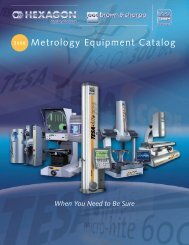shaping the future of metrology - Brown & Sharpe
shaping the future of metrology - Brown & Sharpe
shaping the future of metrology - Brown & Sharpe
Create successful ePaper yourself
Turn your PDF publications into a flip-book with our unique Google optimized e-Paper software.
Tech<br />
Tip<br />
easurement <strong>of</strong> a threaded hole on a coordinate<br />
measuring machine has traditionally been performed<br />
using several methods. For users <strong>of</strong> s<strong>of</strong>tware such<br />
as MicroMeasure ® IV, TUTOR for WINDOWS and PC-DMIS for WINDOWS , <strong>the</strong> easiest choice is to simply ignore <strong>the</strong><br />
thread and measure <strong>the</strong> hole as a circular feature. Ano<strong>the</strong>r<br />
option is <strong>the</strong> use <strong>of</strong> flex plugs. QUINDOS ® M<br />
users have <strong>the</strong><br />
ability to evaluate <strong>the</strong> entire thread by calculating features<br />
such as pitch, lead, and thread pr<strong>of</strong>ile.<br />
This Tech Tip will focus on <strong>the</strong> majority <strong>of</strong> CMM users who<br />
do not have access to high level evaluation tools, and are<br />
only interested in thread location. The method discussed is<br />
that <strong>of</strong> “walking” <strong>the</strong> probe along <strong>the</strong> thread pitch.<br />
Ignoring <strong>the</strong> thread pitch has obvious accuracy problems,<br />
but may be acceptable if <strong>the</strong> positional tolerance is fairly<br />
open. The use <strong>of</strong> flex plugs, while being accurate, requires<br />
<strong>the</strong> operator to insert <strong>the</strong>se plugs into all threaded holes before<br />
<strong>the</strong> part is inspected. Walking <strong>the</strong> probe along <strong>the</strong> thread<br />
pitch is more accurate than ignoring <strong>the</strong> thread, but requires<br />
no additional operator intervention.<br />
Measuring a Threaded<br />
Hole <strong>the</strong> Easy Way<br />
by Greg Privette<br />
Applications Engineer<br />
<strong>Brown</strong> & <strong>Sharpe</strong><br />
A cross section <strong>of</strong> a<br />
threaded hole, and <strong>the</strong><br />
corresponding point locations.<br />
In performing <strong>the</strong> calculations to determine how to adjust<br />
<strong>the</strong> depth, <strong>the</strong> thread pitch and number <strong>of</strong> points are <strong>the</strong> only<br />
parameters needed. A 20 pitch thread using four points is<br />
used for an example:<br />
A 20 pitch thread has 20 threads per inch, or .05 (1/20)<br />
inches per thread. Therefore, to measure one revolution on <strong>the</strong><br />
thread, <strong>the</strong> probe must be dropped .0125 (.05/4) inches per<br />
point. Remember, <strong>the</strong>se points must be equally spaced for this<br />
to be valid.<br />
Following is a generic subroutine for MicroMeasure IV that<br />
measures a threaded hole in <strong>the</strong> XY reference plane.<br />
THREAD =SUBROUTINE/START;<br />
!$1 = NAME OF NEW CIRCLE<br />
!$2 = LOCATION IN X DIR.<br />
!$3 = LOCATION IN Y DIR.<br />
!$4 = LOCATION IN Z DIR.<br />
!$5 = DIAMETER<br />
!$6 = THREAD PITCH (ENGLISH)<br />
!THIS SUB ALWAYS USES FOUR HITS<br />
MOVE/TO;$2,$3,$4+.5<br />
WALK = 1/($6 *4)<br />
$1 =GEOM/CIR;XYPL<br />
MEASURE/;$2-$5/2,$3,$4,-1,0,0,0<br />
MEASURE/;$2,$3+$5/2,$4-WALK,0,1,0,0<br />
MEASURE/;$2+$5/2,$3,$4-2*WALK,-1,0,0,0<br />
MEASURE/;$2,$3-$5/2,$4-3*WALK,0,-1,0,0<br />
DONE/;<br />
MOVE/TO;$2,$3,$4+.5<br />
SUBROUTINE/END;<br />
Circle 710 on <strong>the</strong> READER SERVICE CARD<br />
mfg. The <strong>Brown</strong> & <strong>Sharpe</strong> Publication <strong>of</strong> Precision Manufacturing<br />
31



